class: center, middle, inverse, title-slide .title[ # Social Issues and Social Media ] .author[ ### David Garcia <br><br> <em>University of Konstanz</em> ] .date[ ### Social Media Data Analysis ] --- layout: true <div class="my-footer"><span>David Garcia - Social Media Data Analysis</span></div> --- # Project guidance week - **24.07-28.07: Last week to ask questions or for guidance about projects** - 26.07, 14:00-16:00: Online session for group discussion about projects - Link can be found on Discord and Ilias - **28.07: Deadline for registering your project topic and approach on Ilias forum** - Thanks for the lecture and tutorial feedback! Your input helps improving the course --- # Outline ## 1. Polarization and digital technologies ## 2. Misinformation and information disorder ## 3. Representation issues - The case of Twitter --- # Definitions: Opinion polarization <img src="figures/Polarization1.png" width="480" style="display: block; margin: auto;" /> **Opinion polarization:** Two opinion groups with extreme distance in between [Political Polarization in the American Public. Fiorina & Abrams (2008)](https://www.annualreviews.org/doi/10.1146/annurev.polisci.11.053106.153836) --- # Definitions: Relational polarization <img src="figures/Polarization2.jpg" width="680" style="display: block; margin: auto;" /> **Relational polarization:** Social structure divided into two groups with high internal connectivity and low inter-group connectivity [A sign of the times? Weak and strong polarization in the U.S. Congress, 1973–2016. Neal (2020)](https://www.sciencedirect.com/science/article/abs/pii/S0378873317303039) --- # Echo chambers vs filter bubbles Early definitions of the filter bubble focused on search results and personalization but not on polarized social structures (algorithmic definition). </br> [The filter bubble: What the Internet is hiding from you. Eli Pariser (2011)](https://www.amazon.de/Filter-Bubble-What-Internet-Hiding/dp/1594203008) Axel Bruns's definitions to distinguish echo chambers from filter bubbles: - An **echo chamber** comes into being where a group of participants choose to preferentially connect with each other, to the exclusion of outsiders. - A **filter bubble** emerges when a group of participants, independent of the underlying network structures of their connections with others, choose to preferentially communicate with each other, to the exclusion of outsiders. [Echo chamber? What echo chamber? Reviewing the evidence Axel Bruns (2017)](https://snurb.info/files/2017/Echo%20Chamber.pdf) </br> [Are filter bubbles real? Axel Bruns (2019)](https://www.wiley.com/en-us/Are+Filter+Bubbles+Real%3F-p-9781509536443) --- # Definitions: Affective polarization <img src="figures/Polarization3.jpeg" width="680" style="display: block; margin: auto;" /> **Affective polarization:** Extreme support within groups and hate across groups [The Origins and Consequences of Affective Polarization in the United States. Iyengar et al. Annual Review of Political Science (2019)](https://www.annualreviews.org/doi/abs/10.1146/annurev-polisci-051117-073034) [Political sectarianism in America. Finkel et al. Science (2020)](https://science.sciencemag.org/content/370/6516/533) --- ## The leaving Facebook experiment: US case <img src="figures/FB1.png" width="600" style="display: block; margin: auto;" /> [The welfare effects of social media. Allcott et al. (2019)](https://web.stanford.edu/~gentzkow/research/facebook.pdf) --- ### When leaving Facebook makes things worse: The Bosnia case <img src="figures/FB2.jpg" width="900" style="display: block; margin: auto;" /> [Testing the effects of Facebook usage in an ethnically polarized setting. Asimovic et al. (2021)](https://www.pnas.org/content/118/25/e2022819118) --- # Backfire effects on Twitter experiments <img src="figures/Twitter1.jpg" width="1000" style="display: block; margin: auto;" /> [Exposure to opposing views on social media can increase political polarization. Bail et al. (2018)](https://www.pnas.org/content/115/37/9216) --- # Does social media create polarization? The role of social media is not the same in all conflicts. The question "does social media create polarization?" implies an oversimplification of the problem: - use of social media (e.g. Facebook vs Twitter) - the definition of polarization (e.g. affective vs opinions) - the social context of polarized societies (e.g. partisan vs ethnic). The issue of polarization is an example of why we need precise and robust definitions, why we need research on many different platforms, and why we need no-WEIRD (Western, Educated, Industrialized, Rich and Democratic) populations in research. --- # Misinformation and information disorder ## 1. Polarization and digital technologies ## *2. Misinformation and information disorder* ## 3. Representation issues - The case of Twitter --- # The hot topic of fake news <img src="figures/fakenews.png" width="800" style="display: block; margin: auto;" /> Number of publications including the term "fake news" per year, Dimensions.ai --- ### Fake news during the 2016 US presidential election <img src="https://img.buzzfeed.com/buzzfeed-static/static/2016-11/2/15/asset/buzzfeed-prod-web06/sub-buzz-8001-1478115629-1.jpg?downsize=700%3A%2A&output-quality=auto&output-format=auto" width="950" style="display: block; margin: auto;" /> https://www.buzzfeednews.com/article/craigsilverman/how-macedonia-became-a-global-hub-for-pro-trump-misinfo --- ## Clickbait made in Veles, North Macedonia <img src="figures/TrumpFakeNews.png" width="1200" style="display: block; margin: auto;" /> [The Macedonian Fake News Industry and the 2016 US Election. H. Hughes and I. Waismel-Manor (2021)](https://www.cambridge.org/core/journals/ps-political-science-and-politics/article/macedonian-fake-news-industry-and-the-2016-us-election/79F67A4F23148D230F120A3BD7E3384F) --- # Terminology about misinformation <img src="figures/misinfoClasses.png" width="1200" /> - **False information:** - False or fake news: news-like content that is verifiably false - False rumours: General talk or hearsay not based on factual knowledge - Factitious information blends: half-truths and speculations - Satire and parody - Deep fakes and cheap fakes <div style="font-size:15pt"> Technology and democracy: Understanding the influence of online technologies on political behaviour and decision-making. S. Lewandowsky, et al. (2020) </div> --- # Terminology about misinformation <img src="figures/misinfoClasses.png" width="1200" /> - **Information disorders:** - **Misinformation:** false or misleading content shared without malicious intent - **Disinformation:** false or fabricated content shared with the intent to mislead or cause harm - **Malinformation:** true information shared to cause harm (hate speech, private information) <div style="font-size:15pt"> Information disorder: Toward an interdisciplinary framework for research and policymaking. C. Wardle and H. Derakhshan (2017) </div> --- # Terminology about misinformation <img src="figures/misinfoClasses.png" width="1200" /> - **Propaganda:** Information, especially of a biased or misleading nature, used to promote a political cause or point of view. Can be political or industrial - **Systematic lies:** Carefully constructed fabrications or obfuscations (e.g. weapons of mass destruction in Irak) - **Conspiracy theories:** Alternative explanations for traditional news events which assume that these events are controlled by a secret elite group --- # Comparing fact-checked content <img src="figures/snopes.png" width="700" style="display: block; margin: auto;" /> <center>**Caution: True Snoped tweets != Legitimate news sharing**</center> [The spread of true and false news online. S. Vosoughi, D. Roy, S. Aral (2018)](https://www.science.org/doi/10.1126/science.aap9559) --- # Detection via domain quality lists <img src="figures/List.jpg" width="1200" style="display: block; margin: auto;" /> <div style="font-size:15pt"> Fighting misinformation on social media using crowdsourced judgments of news source G. Pennycook, D. Rand (2019) Fake news on Twitter during the 2016 US presidential election. N. Grinberg, et al (2018) </div> --- ### When the users help spreading: Collaborative disinformation <img src="figures/capitol.png" width="530" /> <img src="figures/capitol2.png" width="540" /> <div style="font-size:15pt"> Misinformation or expressive responding? What an inauguration crowd can tell us about the source of political misinformation in surveys. Schaffner & Luks. Public Opinion Quarterly (2018) </div> Disinformation's spread: bots, trolls and all of us. K. Starbird (2019) --- ## Fighting misinformation: priming and inoculation <img src="figures/Fight.png" width="950" style="display: block; margin: auto;" /> <div style="font-size:15pt"> Shifting attention to accuracy can reduce misinformation online. G. Pennycook, et al. (2021) </div> <div style="font-size:15pt"> Countering misinformation and fake news through inoculation and prebunking. S. Lewandowsky, S. Van Der Linden (2021) </div> --- # Representation issues - The case of Twitter ## 1. Polarization and digital technologies ## 2. Misinformation and information disorder ## *3. Representation issues - The case of Twitter* --- # Politicians on Twitter .pull-left[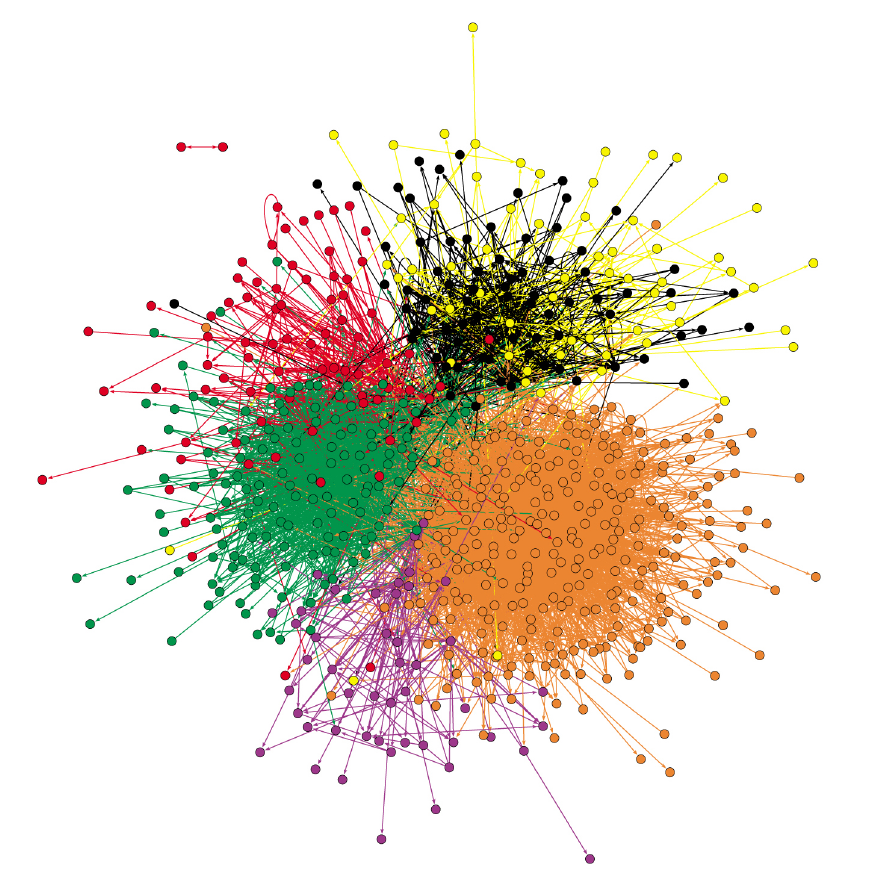] .pull-right[ - Example of social network among German Politicians on Twitter [from Lietz et al, 2014](http://www.aaai.org/ocs/index.php/ICWSM/ICWSM14/paper/viewPaper/8069) - Nodes are the Twitter accounts of politicians - Directed links link a politician that follows another - Node color corresponds to the party of a politician - Force-directed layout ] --- ## Predicting the German elections with Twitter .center[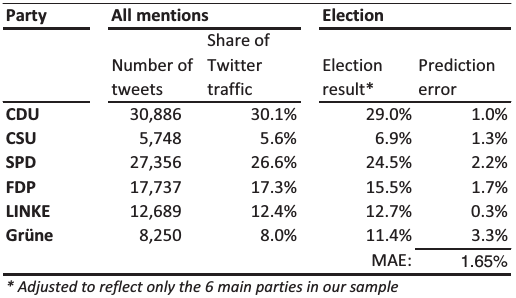] - German election Twitter prediction, from [Tumasjan et al, 2010](http://www.aaai.org/ocs/index.php/ICWSM/ICWSM10/paper/view/1441) - Same ranking, prediction errors on average less than 2%! - "the mere number of messages reflects the election result and even comes close to traditional election polls". Why are we still using traditional surveys? --- # The Victory of the Pirate Party .center[] - Study replication by [Jungherr et al, 2012](https://journals.sagepub.com/doi/abs/10.1177/0894439311404119?journalCode=ssce). - Not to judge parties beforehand, they included the Pirate Party too, not just the six most voted parties in the previous election. - The Pirate Party would have won by landslide, with almost double the mentions the second party got on Twitter --- ## Comparing original results and replication <img src="SocialIssues_files/figure-html/unnamed-chunk-18-1.png" style="display: block; margin: auto;" /> Jugherr and colleagues found other issues with the original prediction, for example how small changes in the dates considered for the analysis had a dramatic impact on the results. --- # Who uses Twitter? .pull-left[ 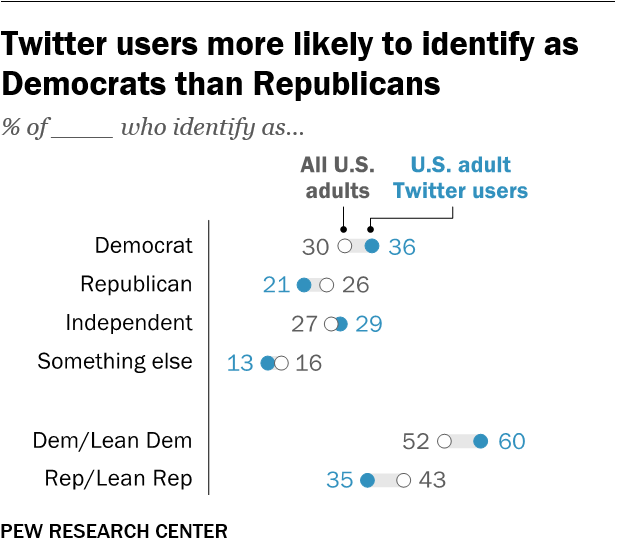] .pull-right[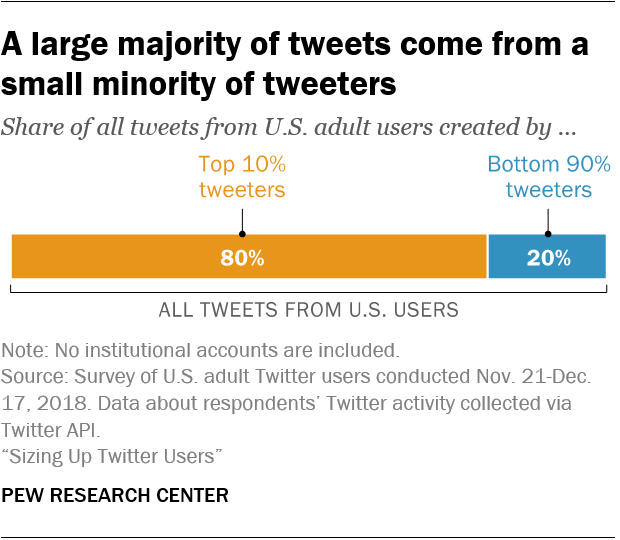] [Pew Internet Research survey data from 2018](https://www.pewresearch.org/fact-tank/2019/08/02/10-facts-about-americans-and-twitter/) --- ## Can we predict election results with Twitter? .center[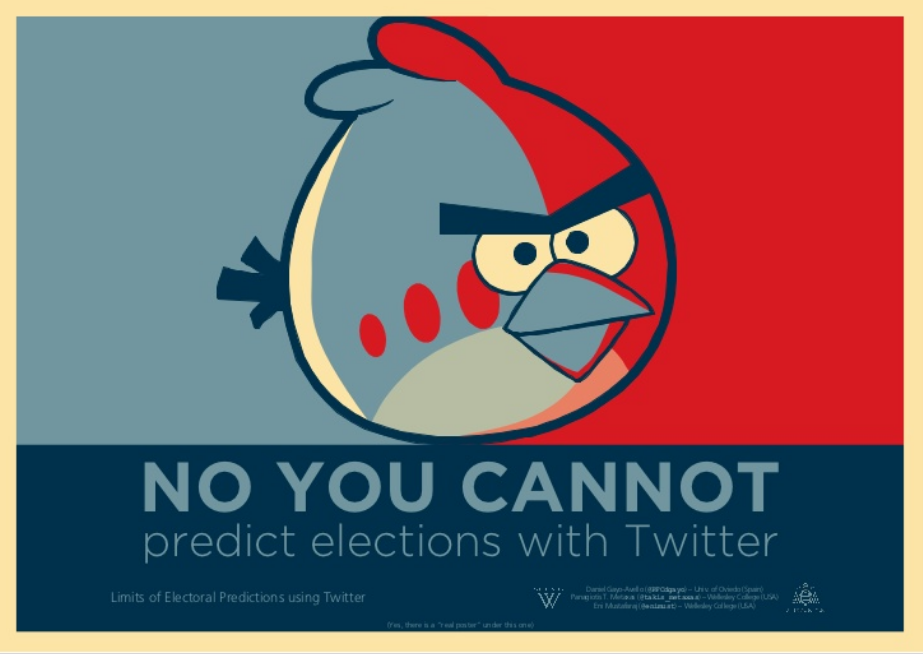 by Daniel Gayo-Avello **Estimating public opinion through tweets suffers self-selection bias** ] --- # Summary - **Polarization and digital technologies** - Definitions: opinions, relations, and affect - Echo chambers and filter bubbles - Experiments and questions about the role of social media - **Misinformation and information disorder** - How fake news became an issue in 2016 - Terminology about misinformation and information disorder - Detecting and intervening on misinformation - **Representation issues - The case of Twitter** - Political research using Twitter - Predicting elections with Twitter data? - Comparing Twitter users and the rest of the population